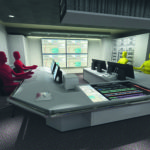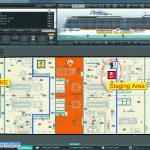The newly designed safety center by Martec bases upon a safety monitoring and control system and integrates data of a decision support, remote access, and people tracking system
Recent accidents occurred on cruise vessels clearly showed that common safety monitoring and control systems (SMCS) as well as safety[ds_preview] equipments are not enough developed to cope with challenges of modern cruise vessels. One of the relevant aspects is related to information. The problem is not to have enough data, but to have a system that can show only the most important information simultaneously, in order to give a clear overview on what is occurring on the ship during an emergency event. A second problem is related to the crew, which is not always sufficiently trained to manage all the emergencies that they could face. This severely limits the reaction speed. Thus, a necessary innovation is a system which can guide the crew, whatever is their training level, to solve the emergency in the best way.
Another important aspect to be improved is the stress management, both on crew and passengers. If the crew does not understand what is happening and does not know exactly what to do, they could react with large delay to the emergency episode, with all the related consequences. Panic conditions might be generated and could propagate to the passengers. As a consequence, the situation could easily get out of control. To avoid those conditions it is very important to know exactly where every crew member is, in order to give him precise instructions on what to do and thus solve the emergency at its first appearance.
Summarizing, the main problems in proper managing the safety on large passenger ships are:
• insufficient training level of the crew for the emergency conditions they could face;
• delays and inefficiencies on the emergency reaction which might allow large damages on board;
• crew panic and propagation among passengers and chaotic rescue operations and ship’s evacuation.
First of all, it is important to have a state-of-the-art decision support system (DSS) on board. DSS is a software tool which helps operators, even low experienced ones, in handling emergencies conditions. It automatically »understands« the emergency (i.e. kind and location of the emergency, equipments affected and ship’s operational role) and suggests the specific best procedure to solve it.
Furthermore, DSS should be able to support an equipment re-configuration after damage occurrence, in order to guarantee a safe return to port (according Safe Return to Port regulation). To be more specific, a state-of-the-art DSS provides a set of actions to be executed to fight the emergency, plus additional questions to drive the execution flow according to the evolution of the emergency. The action flows are prepared based on the company’s emergency procedures defined by the shipowner. A DSS can largely improve the crew’s capability of solving every emergency at its first appearance, avoiding damage to the ship and stress/panic propagation.
A second important tool to have on board is a remote access system (RAS) providing access to the emergency information outside the ship’s network. This system allows actors, other than crew members, to support and drive the emergency reaction’s activity. For example, safety experts from the company’s emergency response centre could use the RAS to receive all the relevant information in real time and, thus, could assist the crew on accident evaluation and fighting. An important thing to mention is that the RAS must be carefully designed in order to protect the ship’s network, avoiding external entities to drive automatic actions on the ship’s equipments.
A further tool that could drastically improve the emergency management is a people tracking system (PTS). The PTS is an indoor positioning system that allows monitoring the position of people, who are carrying a specific identifier device. Very few reliable PTS systems for cruise vessels are currently available. An example of implementation of PTS is based on RFID technology, which at the moment is the state of the art for detection in spaces with complex layout, i.e. large ships. Crew members are wearing an RFID transponder (TAG), whose location is detected by RFID antennas distributed over the ship.
When a good and reliable PTS is available for crew members, the safety team can effectively locate all of the operators and drive them through proper actions without loosing precious seconds. When a positioning system is available for passengers, it is possible to largely improve passenger management, rescue operations, and, ultimately, ship evacuation management.
Knowing where crew and passenger are, knowing what are the best actions to implement when reacting to a specific accident and having support from outside the ship, are all important items to improve safety on board, but, alone, they are not enough.
These systems have to be integrated and the generated data has to be effectively accessible. In fact, during emergency many information are generated, for example: fire detection alarms, equipment malfunctioning signals, ship’s stability information, CCTV video streaming, doors and fan status, people positioning data, and suggested actions from DSS and from the company’s emergency response centre. All of these data could potentially be important. However, it could easily overwhelm a safety team on board. This can cause severe damage to the ship’s equipments before the operators can find their way through the large amount of information available. Therefore, it is necessary to properly design the on-board safety center in order to optimize team cooperation and to integrate all safety systems in one single point, optimizing data collection and information selection in a sort of »functional integration«.
The safety center developed by Martec is an example of this concept: Ergonomic design, full systems integration capability, and most advanced technologies (like multitouch tactical table and large LCD videowall), allow to capture in one unique screen-
shot the whole ship’s safety situation, optimizing safety team interaction and improving emergency reaction speed.
The infrastructure is based on a safety monitoring and control system (SMCS) that allows a functional integration of multiple systems on a unique interface. Safety team operators are ergonomically seated to allow clear and easy exchanges of information. Each workstation could operate on few sub-systems while sending its video output to a large video wall. All most critical status information are properly combined through a video server and projected simultaneously on the mentioned video wall to be seen by everyone in the safety center. Furthermore, a large horizontally-mounted touch screen is used by the Staff Captain as tactical table to overview the ship’s condition, to interrogate and control systems, and to record actions. Finally, a well designed safety center is very effective as a tool for crew training.
An example of this new safety center concept has been developed by Martec together with Carnival Corporate Shipbuilding and will be installed on the »Royal Princess«, which is to be delivered in June.
Marco Annese, Vittorio De Val, Gian Giacomo Fogazzaro




















